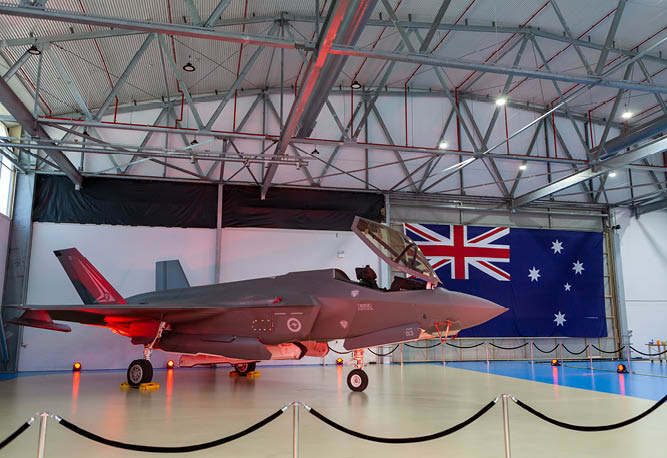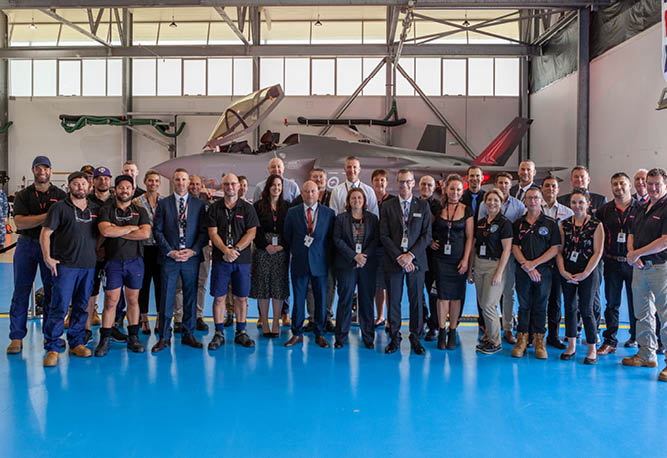The F-35 Lighting II Joint Strike Fighter is one of the most advanced aircrafts in the world. A fifth-generation multi-role fighter, the F-35 signals a new era of Australian air power.
In 2015, BAE Systems Australia was assigned to sustain the Royal Australia Air Force’s fleet of F-35 fighter jets. The F-35 is sustained and upgraded at the Southern Pacific Regional Airframe Depot in Williamtown, NSW. From this facility, BAE Systems Australia will support F-35 aircraft from across the region. The facility will also be home to a BAE Systems Australia managed Asia Pacific Regional Warehouse where spares will be provided to operational units across the region. BAE Systems Australia will also maintain key F-35 components at the Williamtown facility when the Asia Pacific component Depot capability activates over the coming years.
In January 2021, the first F-35 arrived at BAE Systems Australia’s Williamtown Depot. We sat down with Derren Shaw, F-35 Program Manager at BAE Systems Australia, to hear how the program has grown and what is to come as the program enters the next phase.
What is most exciting about your leadership role in the F-35 program?
This year is the RAAF’s 100th birthday and it was a great time to welcome the first F-35 to our hangar. It is a huge privilege to support the RAAF and to be on this journey with the F-35 fleet.
For me, the size, scale and complexity of the program is really exciting and the only way that this program can be successful is through collaboration. It is exciting to see collaboration play out in reality across Government, Industry Primes, the Royal Australian Air Force and our wide chain of sovereign suppliers.
Relationships are so important across this Program. As we activated the Depot, all parties actively invested in relationship building which set the program up for success. This became even more important when COVID-19 hit, with face-to-face interaction limited and international borders closed, all parties relied heavily on the relationships built over the last few years. People pulled together across multiple organisations, spending many hours on calls at either end of the day, to make sure that our Depot got off the ground successfully.
Working from our Williamtown facility, I feel privileged to be able to look up and see the RAAF flying the F-35 and knowing the part we play in its success. As a leader, it is great to see the impact of our team in supporting these pilots and crews. From a workforce perspective, as we grow our workforce, it is special to see apprentices coming through the program right now who are at the start of their careers and very excited to be working in the early stages of such a significant program.

Can you tell us about the sustainment routine for the aircraft?
BAE Systems Australia is supporting the sustainment space in two areas. Firstly, as part of the Global Support Solution (GSS) we have been assigned regional Product Support Provider (PSP) roles for Airframe Maintenance Repair Overhaul & Upgrade (MRO&U), Component repair and Regional Warehouse.
We activated the Depot in December 2019 ready for any unscheduled Depot events when the aircraft started to arrive in country. In January 2021, we inducted our first jet, which marked the commencement of scheduled MRO&U in the Depot as well as continuing to be available for any unscheduled depot-level repair required. Currently, we are supporting over 30 Australian aircraft that are already in country. Ultimately, we will support the entire Australian fleet, 72 aircraft, as well as the wider South Pacific regional fleet.
We also support the RAAF directly with operational sustainment activities and our people are fully embedded with RAAF squadrons at RAAF Williamtown, working side by side to deliver these activities.
What sort of operational training did your teams undergo to resource the program?
It’s been quite a long process, initially several of our technicians travelled to Fort Worth, Texas to receive training on the F-35 at the Production Plant delivered by Lockheed Martin. Our technicians then underwent ‘train the trainer’ programs to enable them to deliver training on the ground in Australia to build our in-country capability as the depot grows. Our technicians also received on the job training at RAAF Base Williamtown under the guidance of the RAAF. It’s been an exciting process and it’s great to see Australia’s skilled workforce grow as we continue to develop this important sovereign capability.

What have been the biggest benefits of the F-35 program to the Hunter region?
The F-35 program will require ongoing support for decades to come, creating generations of jobs for the local and national economy as well as the wider sovereign supply chain.
While the program is currently in its early stages, by 2025 it will contribute 750 jobs directly and indirectly, across the national economy. Our supply chain will also benefit as we expect to purchase from 76 companies across the country to support the program by 2025.
Few projects offer so much opportunity and longevity both locally and nationally.
How do you address component repair and overall supply chain for the program?
Under the Global Support Solution construct, a network of Repair Depots and Original Equipment Manufacturers (OEMs) across the globe support component repair. Depot level repair capability broadly splits into three regions: the United States, Europe and Asia Pacific, with capability being progressively stood across the regions up over time.
Over the next few years, the Asia Pacific will start to stand up its Component Depots with BAE Systems Australia activating some of these capabilities at Williamtown, NSW. We will then repair parts not only from Australian jets on our site but from other operators in the region, which will serve to further grow Williamtown as a Regional F-35 Hub.
Learn more about the F-35 at www.baesystems.com
main picture: BAE Facility at Williamtown. BAE image.














